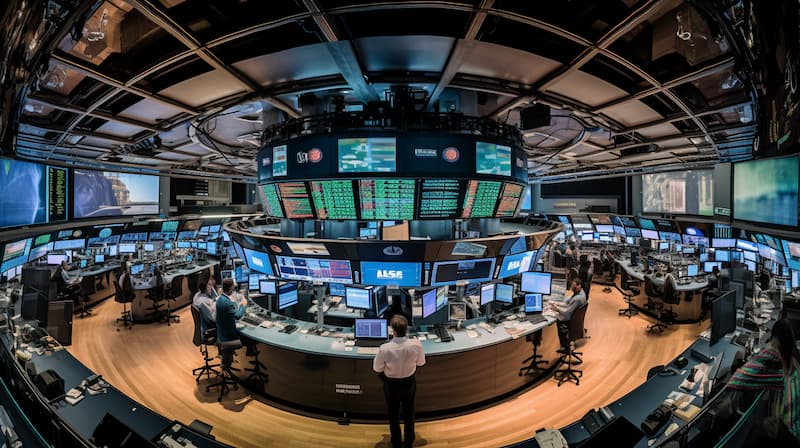The Potential of AI: A Game-Changing Investment
AI has taken center stage in the tech sector following the launch of Microsoft-backed OpenAI's ChatGPT bot in November. With this, experienced investors find themselves exploring undervalued opportunities in a space that seems to be brimming with potential yet carries the risk of becoming overvalued.
Shares in AI and tech companies have soared since ChatGPT's release, showcasing the enormous economic implications of AI. For instance, Nvidia (NVDA.O), the company producing computer chips for AI systems, saw its shares double, while AI software company C3.AI and Palantir Technologies (PLTR.N) also saw considerable upticks.
The primary driver behind this investment wave is the revolutionary technology known as generative AI. This type of AI learns from vast datasets to create text, images, and computer code, and its applications promise to revolutionize industries such as video editing, recruitment, and legal work. Consultancy PwC predicts AI-related productivity savings and investments could generate a staggering $15.7 trillion worth of global economic output by 2030, nearly equal to China's GDP.
An Investor's Conundrum: Jump In or Wait Out?
While the figures are tantalizing, investors face a conundrum. Should they join the AI train now, or exercise caution, given regulators' growing concerns about AI's potentially disruptive impact? As Niall O'Sullivan, chief investment officer of multi-asset for EMEA at Neuberger Berman, puts it, "There are clearly going to be winners in all this," but it's hard to foresee where exactly those victories lie.
Some seasoned investors advocate a cautious approach. They see merit in backing already proven tech companies poised to benefit from the long-term AI trend, instead of hot startups or high-valued AI-themed businesses that might not deliver. Tech fund manager Alison Porter, for instance, points out that we are still in the early stages of AI use cases and advocates for large tech groups like Microsoft (MSFT.O) and Alphabet (GOOGL.O) with "strong balance sheets" and the ability to invest in diverse technology advances.
The Hype Cycle: Walking the Fine Line
Investors also need to be wary of the hype cycle, which often starts with a trigger, followed by inflated expectations and then disillusionment. In this context, the launch of ChatGPT could be seen as the trigger. The question, as Mark Hawtin of GAM Investments raises, is where AI currently stands in this cycle, and how best to get exposure to the theme without picking an overvalued option.
The Picks and Shovels Approach
Some investors, like Janus' Porter, recommend supporting established companies that could become "big beneficiaries in terms of providing infrastructure" for future AI trends. These "picks and shovels" companies are critical to enabling new AI technology. Given that AI systems require huge volumes of data to learn from, companies that deal with data storage and hard drives, such as Seagate Technology (STX.O), and chipmaker Marvell Technology, can be appealing investments.
Management consultancy Accenture also has its appeal as businesses need experts to guide them on how to leverage AI, according to Jon Guinness, tech portfolio manager at Fidelity International.
The Continued Dominance of Big Tech
Trevor Greetham, head of multi-asset at Royal London Investment Management, warns against investing in AI-themed stocks, as "there will be an awful lot of losing lottery tickets." He suggests staying with dominant tech stocks, partly because AI supports their valuations. Likewise, Fidelity's Guinness holds Amazon in his funds, given its efforts to make AI less expensive as Alison Porter of Janus points out, the substantial benefits of AI will unfold over time. Investors eager to capitalize on the AI boom need to exercise prudence, patience, and a keen understanding of the landscape. As she succinctly puts it, "We would never blindly buy into AI and we don't do things at any price."
Navigating AI's Disruptive Impact: A Regulatory Challenge
The ongoing surge in AI investments also brings to the forefront potential regulatory concerns. The disruptive potential of AI technologies is a double-edged sword that can drive innovation but may also pose unforeseen risks. Policymakers worldwide are wrestling with the challenge of formulating balanced regulations to mitigate these risks without stifling innovation.
The Role of AI Consultancies: Bridging the Gap
As businesses consider integrating AI into their operations, there is a rising need for expert guidance to navigate this complex landscape. Consulting firms like Accenture play an increasingly crucial role in assisting businesses to harness AI's potential responsibly and effectively. By providing expert advice, they are helping businesses make informed decisions about using AI, driving both the adoption of the technology and its responsible use.
The Long-Term Perspective: Sustainable Growth Over Immediate Gains
In the face of dazzling valuations and rapid advancements in AI, it's crucial for investors to maintain a long-term perspective. While AI-themed stocks can offer quick returns, their volatile nature can also lead to significant losses. The tech veterans' approach, as demonstrated by Alison Porter, advocates for a measured stance focusing on sustainable growth over immediate gains. By maintaining such a perspective, investors can avoid getting caught up in the hype and make decisions that stand the test of time.
The AI Boom: A Marathon, Not a Sprint
To sum it up, the investment frenzy around AI is indicative of the technology's transformative potential. However, like any other technological advancement, it's vital to approach it with caution and understanding. Investing in AI is more of a marathon than a sprint, with the long-term winners likely to be those who display patience, conduct thorough due diligence, and navigate the AI landscape with a balance of enthusiasm and caution.
As the AI wave continues to roll, investors must remember that while this is a promising frontier, not every investment will be a gold mine. Understanding the landscape, making informed decisions, and being prepared for the long haul will be key to reaping the benefits of the AI boom while mitigating the risks.







